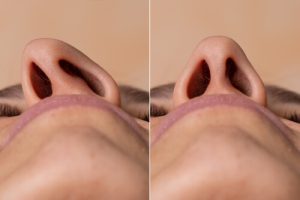Breathing easily might be second nature for many, but for some, an unseen obstacle can make this fundamental act a challenge. Dive into the world of nasal anatomy, and you’ll encounter the term deviated septum. But what is deviated septum? It’s more than just a medical jargon; it’s a common condition that can influence breathing, sleep, and even the quality of life. Understanding its intricacies is the first step to finding relief and breathing easier again.
Effect of Deviation of Nasal Septum
The deviation of the nasal septum can significantly affect both breathing and sleep quality, reducing quality of life and potential health risks. Understanding these implications is vital for seeking appropriate medical advice and treatment options. Whether through medication or surgical intervention, addressing the issue can improve well-being and overall health.
Breathing Difficulties
- Obstructed Airflow: One of the primary issues a deviated septum can cause is obstructed airflow in one or both nostrils. This condition can make breathing difficult through the nose, forcing the individual to breathe through the mouth. Breathing through the mouth often is less efficient and can lead to other health issues like dry mouth.
- Chronic Sinusitis: The deviation may cause poor drainage of the sinuses, which can lead to chronic sinusitis. This condition further exacerbates breathing difficulties, leading to a perpetual cycle of respiratory issues.
- Exercise and Physical Activity: Breathing issues related to a deviated septum can become even more apparent during exercise or any form of strenuous physical activity. This condition may limit athletic performance and can be a significant barrier for those leading an active lifestyle.
Sleep Problems
Snoring and Sleep Apnea: A deviated nasal septum can cause noisy breathing during sleep, commonly called snoring. More severely, it can contribute to conditions like sleep apnea, which involves periodic cessation of breathing during sleep. If left untreated, sleep apnea can lead to poor sleep quality, daytime drowsiness, and even severe health conditions like hypertension and heart disease.
- Interrupted Sleep Cycles: Difficulty breathing can lead to frequent waking at night, disrupting natural sleep cycles. Lack of restful sleep can result in daytime fatigue, affecting overall productivity and well-being.
- Mouth Breathing and Dry Mouth: A deviated septum may force individuals to breathe through their mouths. This can lead to dry mouth and increased susceptibility to dental issues like cavities and gum disease since saliva production is less during sleep. Saliva is necessary to neutralise the acids in the mouth.
Septal Deviation Causes and Risk Factors
A deviated septum is a condition where the nasal septum — the bone and cartilage that divide the nasal cavity in half — is significantly off-centre or crooked. While this can create breathing difficulties and sleep problems, it’s essential to understand the potential causes and risk factors associated with this condition. Here are some of the most common:
- Genetic Predisposition: A deviated septum is a condition you’re born with passed down through family genetics. If other family members have had issues with their nasal septum or related respiratory concerns, you may be at greater risk.
- Accidents: One of the most common causes of a deviated septum is trauma to the nose. This can occur during accidents, fights, or any activity that may cause a forceful impact on the face.
- Sports Injuries: Participation in high-impact or contact sports, like football, rugby, or boxing, can also increase the risk of developing a deviated septum due to the potential for facial trauma.
- Aging Process: As we age, the structures of our noses may gradually shift or deteriorate, leading to a deviated septum over time. Although less common than trauma-induced deviation, the aging process can still be a contributing factor.
- Drug Abuse: Some recreational drugs, especially snorted ones, can lead to a deviated septum over time due to their corrosive effect on the nasal cartilage and tissues.
- Occupational Hazards: Exposure to harmful chemicals or pollutants in certain occupations can also contribute to respiratory issues and potentially exacerbate symptoms of a deviated septum.
- Previous Medical Surgeries: A deviated septum can sometimes result from complications from previous medical interventions or surgeries in the nasal area, although this is relatively rare.
Understanding the various causes and risk factors of a deviated septum can help you evaluate your own risk and take preventative measures when possible. If you believe you may have a deviated septum, consult a healthcare professional for a thorough diagnosis and tailored treatment plan.
Signs and Symptoms of a deviated septum
A deviated septum symptoms can manifest in various ways, from subtle to more severe. Some people with a deviated septum may be entirely unaware of the condition due to a lack of symptoms, while others may experience significant discomfort and health issues. Here are some of the most common signs and symptoms associated with a deviated septum:
- Uneven Breathing: One of the most evident signs is difficulty breathing through one or both nostrils. You may find that one nostril allows air to flow freely while the other feels obstructed.
- Chronic Congestion: A deviated septum can also lead to chronic nasal congestion, causing you to feel like your nose is blocked or stuffed up most of the time.
- Poor Drainage: A deviated septum can lead to poor sinus drainage, resulting in recurring sinus infections or sinusitis. These frequent infections can contribute to persistent discomfort and even pain.
Disrupted Sleep: Difficulty in breathing naturally affects sleep quality. People with a deviated septum often snore or experience sleep apnea episodes, disrupting sleep cycles and leading to daytime fatigue.
- Mouth Breathing: As mentioned earlier, a deviated septum may cause individuals to breathe through their mouths, which can lead to issues like dry mouth and increased susceptibility to oral health problems.
- Frequent Episodes: A severely deviated septum can cause the nose’s interior to dry out, resulting in frequent nosebleeds. This issue is especially prevalent in dry or cold climates.
- Sensitive Pressure Points: In some cases, the deviated septum can cause certain pressure points in the nose to become more sensitive, leading to facial pain, headaches, or migraines.
- Excess Mucus: Some people with a deviated septum experience a constant postnasal drip, which involves excess mucus dripping from the back of the nose down the throat, often leading to coughing and irritation.
Diagnosis and Treatment Options
If you’ve been experiencing symptoms that you suspect could be related to a deviated septum, the next step is getting a proper diagnosis and exploring treatment options. A deviated septum can significantly affect your quality of life, so it’s essential to address it. Below are common diagnostic methods and treatments for this condition.
Diagnostic Procedures
- Physical Examination: A healthcare provider may begin with a thorough physical examination of your nose, which often involves using a nasal speculum to widen the nostrils for a better view of the septum.
- Imaging Tests: In some cases, imaging tests like X-rays or CT scans may be necessary for a more detailed view of the nasal septum and surrounding structures.
- Medical History: Your doctor will likely ask about your symptoms and any previous nasal injuries or surgeries to better understand your condition.
Conservative Treatments
- Nasal Sprays: Decongestant and nasal steroid sprays can help alleviate symptoms by reducing inflammation and opening up the nasal passages.
- Antihistamines: These medications can help control symptoms if allergies contribute to your breathing difficulties or sinus issues.
- Nasal Strips: These adhesive strips can be applied to the nostrils to mechanically open them wider, providing temporary relief from obstructed airflow.
Surgical Options
Septoplasty: This is the most common deviated septum surgery. During a septoplasty, the surgeon straightens the septum, usually under general anesthesia.
- Turbinectomy: Sometimes, the nasal turbinates (structures on the side wall of the inside of the nasal passage) are also enlarged or inflamed and may need to be reduced through turbinectomy, either alone or in conjunction with septoplasty.
- Rhinoplasty: How is deviated septum treated? In some cases, especially if the external nose is also misshapen, a cosmetic rhinoplasty may be performed alongside septoplasty.
Aftercare and Recovery
- Postoperative Care: After surgery, you may have to wear a nasal splint for a few days, and you’ll need to avoid strenuous activity during the recovery period.
- Monitoring and Follow-up: Regular follow-up appointments will be necessary to monitor the healing process and assess the success of the treatment.
A badly deviated septum can be more than just a minor inconvenience; it can lead to other problems ranging from sleep disturbances to chronic sinusitis. Diagnostic procedures can confirm the condition, and various treatment options are available to address it. Consult a healthcare professional for a personalised plan tailored to your needs.
References:
https://www.healthdirect.gov.au/deviated-septum
https://www.mayoclinic.org/diseases-conditions/deviated-septum/symptoms-causes/syc-20351710
https://my.clevelandclinic.org/health/diseases/16924-deviated-septum
https://www.webmd.com/allergies/deviated-septum
https://www.healthline.com/health/deviated-septum
https://www.hopkinsmedicine.org/health/conditions-and-diseases/deviated-septum


 Snoring and Sleep Apnea: A deviated nasal septum can cause noisy breathing during sleep, commonly called snoring. More severely, it can contribute to conditions like sleep apnea, which involves periodic cessation of breathing during sleep. If left untreated, sleep apnea can lead to poor sleep quality, daytime drowsiness, and even severe health conditions like hypertension and heart disease.
Snoring and Sleep Apnea: A deviated nasal septum can cause noisy breathing during sleep, commonly called snoring. More severely, it can contribute to conditions like sleep apnea, which involves periodic cessation of breathing during sleep. If left untreated, sleep apnea can lead to poor sleep quality, daytime drowsiness, and even severe health conditions like hypertension and heart disease. Disrupted Sleep: Difficulty in breathing naturally affects sleep quality. People with a deviated septum often snore or experience sleep apnea episodes, disrupting sleep cycles and leading to daytime fatigue.
Disrupted Sleep: Difficulty in breathing naturally affects sleep quality. People with a deviated septum often snore or experience sleep apnea episodes, disrupting sleep cycles and leading to daytime fatigue. Septoplasty: This is the most common deviated septum surgery. During a septoplasty, the surgeon straightens the septum, usually under general anesthesia.
Septoplasty: This is the most common deviated septum surgery. During a septoplasty, the surgeon straightens the septum, usually under general anesthesia.
Recent Comments